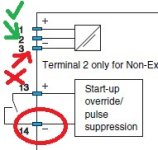Hi all,
We are trying to start up a machine that is operated by 2 motors. There are proximity switches to read speed from each of the moving parts associated with those motors. The signals from those proximity switches are delivered using 3 wires to a signal conditioner (one set of switches and a conditioner per motor). The signal conditioners are Pepperl+Fuchs KFD2-UFC-1.D .
The motors are controlled by VFDs.
The problem we noticed is that the speed read by the conditioners is erratic. In general it's correct until around 10 Hz, then, when we speed the VFD up, is goes up to around double it should be. Sometimes if we go up very slowly, like 1 Hz per minute the speed conditioner seems to tolerate the increase and reads well, but sometimes is doesn't.
We also noticed that the speed signal from the smaller motor (15 hp) is more likely to read well than the one from the big motor (75 hp).
We even ran a cable outside the conduit to rule out a wiring problem like wrong wire or electrical interference.
Has anyone experienced something like this in the past?
Thank you very much in advance!
We are trying to start up a machine that is operated by 2 motors. There are proximity switches to read speed from each of the moving parts associated with those motors. The signals from those proximity switches are delivered using 3 wires to a signal conditioner (one set of switches and a conditioner per motor). The signal conditioners are Pepperl+Fuchs KFD2-UFC-1.D .
The motors are controlled by VFDs.
The problem we noticed is that the speed read by the conditioners is erratic. In general it's correct until around 10 Hz, then, when we speed the VFD up, is goes up to around double it should be. Sometimes if we go up very slowly, like 1 Hz per minute the speed conditioner seems to tolerate the increase and reads well, but sometimes is doesn't.
We also noticed that the speed signal from the smaller motor (15 hp) is more likely to read well than the one from the big motor (75 hp).
We even ran a cable outside the conduit to rule out a wiring problem like wrong wire or electrical interference.
Has anyone experienced something like this in the past?
Thank you very much in advance!







